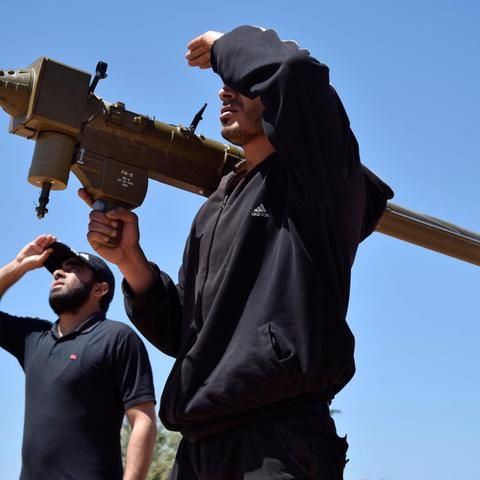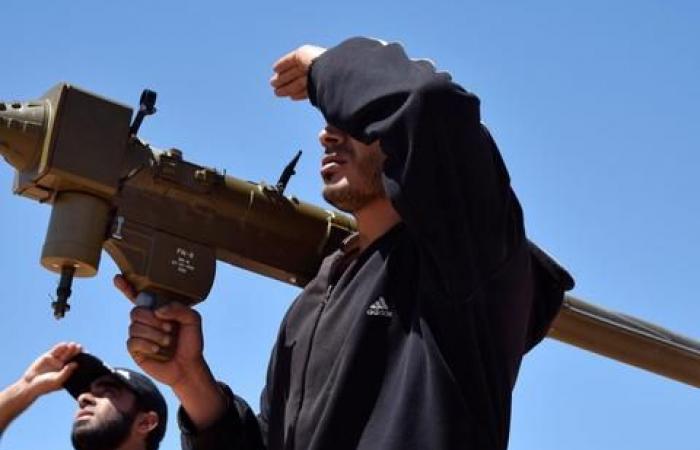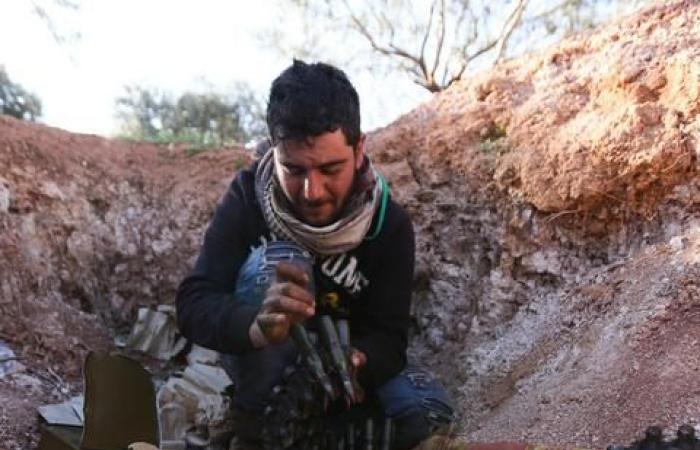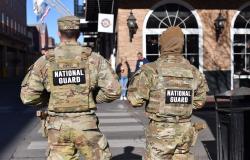Thank you for your reading and interest in the news Syria: What the rebel downing of helicopters means for Idlib bombardment and now with details
Hind Al Soulia - Riyadh - For years, Syrian aircraft have inflicted untold damage on cities, towns and villages up and down the country. One of the most defining features of the nine-year conflict has been aerial bombardment – first by Syria’s air force, followed by Russian jets after President Vladimir Putin intervened in the country in 2015 saying he was fighting terrorism.
The immense destruction and paralysing fear wrought by these attacks has been immortalised in news report after news report, as well as a slew of widely successful Syrian-made films including For Sama and The Cave.
However, earlier this month two incidents suggested that rebels may have found something of a limited riposte.
Man-portable air defence systems, commonly referred to as Manpads, are a hand-held anti-aircraft weapons system capable of downing helicopters and some types of fighter jet.
A Syrian transport helicopter was downed by a Manpad missile over Idlib’s countryside on February 11, followed by another over the western Aleppo countryside on February 14.
Both of those shot down by rebel groups were Russian-designed transport helicopters, known as Mi-8/17s.
While the Syrian Air Force’s estimated fleet of approximately a dozen active Mi-8/17s are used in transport, reconnaissance and supply duties, they are probably most notorious for barrel bombing.
For years, the Syrian air force has flown helicopters over rebel-held areas and dropped oil drums and barrels packed with dynamite, shrapnel and gasoline onto buildings below with devastating effect.
But how crucial a loss were the two helicopters?
Rebel-fighters monitor the sky holding a FN-6 man-portable air-defence system (MANPADS) in the Syrian village of Teir Maalah, near Homs. AFP
The Shayrat airfield in Syria. Donald Trump ordered a massive military strike on a Syrian air base in retaliation for a chemical attack he blamed on President Bashar al-Assad. AFP
Smoke plumes billowing from bombardment by the Syrian government forces and allies on the town of Sarmin, southeast of the city of Idlib. AFP
Smoke billows from a building following a reported bombardment by pro-Syrian government forces in the town of Maaret al-Numan in Syria's Idlib province. AFP
A Syrian Aero L-39 Albatros war plane dropping a payload above buildings across the border in Syria during air strikes backing a Syrian-government-led offensive. AFP
People search for scraps of metal among the debris of a Syrian military helicopter that was shot down in the western countryside of Aleppo province. AFP
A general view shows former Syrian army MiG-23 fighter jets at the Abu Duhur military airport, the last regime-held military base in northwestern Idlib province. AFP
A Russian Mil Mi-24 "Hind" attack helicopter flying in the eastern Syrian region of Deir Ezzor. AFP
Members of Al-Qaeda's Syrian affiliate and its allies sit on top of a former Syrian army MiG-21 figther jet after they seized the Abu Duhur military airport. AFP
An aerial view of smoke plumes billowing from bombardment by the Syrian government forces and allies on the town of Sarmin, southeast of the city of Idlib. AFP.
An image grab taken from a video allegedly shows a Syrian military helicopter being downed on in Syria's war-torn province of Idlib. AFP

Estimates suggest that Syria had more than 460 fixed-wing or rotary combat aircraft and another 76 training aircraft before the outbreak of the uprising in 2011.
That arsenal included Russian or Soviet-made “L-39s, MiG-21s, MiG-23s, MiG-29s, Su-22s, and Su-24s for strike missions, and Mi-8/17s and Mi-24s for barrel bombing and strafing attacks,” according to a 2014 profile by the Washington Institute for Near East Policy.
A recent report by Tobias Schneider, a research fellow at Berlin's Global Public Policy Institute, estimates that there are “six to ten Mi-8/17 helicopters more or less consistently involved in the…barrel bombing campaign” that has led to thousands of civilian deaths.
The total helicopter arsenal in the air force may be closer to 50, although large numbers are believed to be out of service at any one time.
Researchers use a combination of open-source intelligence, satellite imagery and social media to build up a picture of the Syrian military’s hardware.
And while the findings cannot be exact to the last jet, it builds a clear picture of how Syria’s nine-year war has degraded the government’s air capabilities.
Turkish-backed Syrian fighter loads ammunition at a frontline near the town of Saraqib in Idlib province, Syria. AP Photo
Turkey-backed Syrian fighters load their weapons at a position on outskirts of the villages of Afis and Salihiyah nearSaraqib in northwestern Syria. AFP
A Turkey-backed Syrian fighter fires a truck-mounted gun toward the town of Saraqeb from the outskirts of the villages of Afis and Salihiyah. AFP
Turkey-backed Syrian fighters load their weapon at a position on outskirts of the villages of Afis and Salihiyah. AFP
Internally displaced Syrian children walk near the wall in Atmah IDP camp, located near the border with Turkey, in Syria. Reuters
An internally displaced Syrian family sit together outside a tent near the wall in Atmeh IDP camp. Reuters
Internally displaced Syrian boy stands outside a tent near the wall in Atmeh IDP camp. Reuters
Clothes are hanged on a rope to dry near the wall in Atmah IDP camp. Reuters
An internally displaced Syrian boy walks near the wall in Atmah IDP camp. Reuters
A view of the Atmeh IDP camp, located near the border with Turkey, in Syria. Reuters

The two helicopters shot down are not the first. Rebels who previously stormed Syrian army bases commandeered anti-aircraft weapons and some groups received a limited number of Manpads from foreign backers.
Strikes by foreign states, including Israel and the United States, have also badly damaged several Syrian air bases and potentially aircraft too.
According to analyst Nicholas Heras, from the Institute for the Study of War think-tank in Washington DC, “approximately 30 per cent of the Syrian Arab Army’s aircraft is believed to have been destroyed by US action since the start of the conflict.”
The US Department of Defence previously claimed that an April 6, 2017 strike on the Shayrat air base, in response to the Khan Sheikhoun chemical weapons attack, destroyed “20 per cent of Syria’s operational aircraft.”
However, Mr Heras adds, Syria’s air force has been significantly bolstered by the Russian intervention of September 2015.
“One of the key features of the Russian intervention is that the Russians have brought…significant, advanced aircraft – particularly fighter jets.”
Despite the rare strikes against the helicopters this month, the pro-government bombing has not stopped.
After the second helicopter was downed, Syrian forces briefly adjusted their aerial tactics – opting to keep the more vulnerable helicopters back from opposition-held territory.
Perhaps most importantly for the 3 million civilians in the region, this brought a pause in barrel bombings.
Another attempted Manpad strike over the Idlib town of Saraqeb on February 26 reportedly missed its target, a Syrian jet, but did force the aircraft out of opposition airspace.
However, Russian and Syrian jets are still regularly bombarding both rebel positions and hitting civilian communities – including hundreds of thousands of displaced Syrians fleeing northward from the ongoing onslaught.
Updated: February 27, 2020 02:17 PM
These were the details of the news Syria: What the rebel downing of helicopters means for Idlib bombardment for this day. We hope that we have succeeded by giving you the full details and information. To follow all our news, you can subscribe to the alerts system or to one of our different systems to provide you with all that is new.
It is also worth noting that the original news has been published and is available at The National and the editorial team at AlKhaleej Today has confirmed it and it has been modified, and it may have been completely transferred or quoted from it and you can read and follow this news from its main source.






